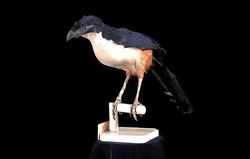Coua delalandei
| Delalande's coua | |
|---|---|
| Turnaround video of specimen RMNH 110100, Naturalis Biodiversity Center | |
| Scientific classification | |
| Kingdom: | Animalia |
| Phylum: | Chordata |
| Class: | Aves |
| Order: | Cuculiformes |
| Family: | Cuculidae |
| Genus: | Coua |
| Species: | † C. delalandei |
| Binomial name | |
|
Coua delalandei (Temminck, 1827) |
|
| Synonyms | |
|
Coccycus delalandei Temminck, 1827 |
|
Coccycus delalandei Temminck, 1827
Delalande's coua (Coua delalandei), also known as snail-eating coua and Delalande's coucal, is an extinct species of non-parasitic cuckoo from Madagascar. It only was known to science as an extant bird for a very short time in the early 19th century. There is some disagreement about its area of occurrence: Although there were claims that the bird was also found in the area of Fito and Maroantsetra as well as near Toamasina (Tamatave), i.e., the coastal areas of northern Toamasina Province, all specimens with good locality data are from the offshore island of Nosy Boraha. As the vernacular name implies, land snails were a favored food item of this species.
Of the 14 specimens that exist nowadays, all but two are known to have taken between 1827 and 1834, many by the surgeon and naturalist Chevalier Joseph Alphonse Bernier. The Paris type specimen was in the collection of the Muséum national d'Histoire naturelle before that date, and one specimen may have been taken as late as 1850. As this species - the second-largest coua extant in modern times - was very spectacular, it was much sought after as a museum piece. However, it probably was restricted to coastal rainforest on Nosy Boraha, and its habitat was largely destroyed by deforestation in the course of the 19th century. Introduction of black rats may also have contributed to its demise, probably less by direct predation than by competition for food, but there probably was a thriving rat population on Nosy Boraha as soon as 1700, considering that the island was a favorite place for pirates to overhaul. Cats, which would have preyed on the bird, were probably introduced only in the 19th century and make a more likely candidate for an introduced species that had a negative impact on Delalande's coua.
...
Wikipedia


